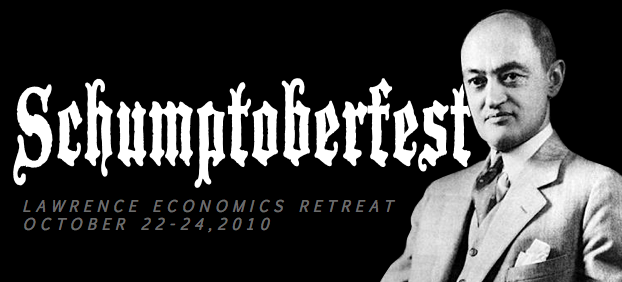Brandenberger and Galambos strike again. This via the Faculty & Grants Fellowships Newsletter:
This summer, the In Pursuit of Innovation course — co-taught by Professors John Brandenberger (Physics) and Adam Galambos (Economics) — received a two-year $23,000 grant from the National Collegiate Inventors and Innovators Alliance substantially to enhance the support for student projects and to fund guest speakers. Team projects play a central role in the course, and the NCIIA grant will allow students to dream bigger and to go further in pursuing their chosen innovations. It is expected that some teams will go beyond producing a prototype and will bring their idea close to being commercialized. The Innovation course, to be offered for the third time in Winter 2011, is one of the core courses of the Innovation & Entrepreneurship program, which is Lawrence University‘s model for integrating innovation and entrepreneurship into liberal arts education.
The program currently features three core courses that are to be complemented by additional topical courses dealing with environmental issues, politics, economic development, and other subjects that reflect interests of participating faculty. As a result of the program, several courses in economics as well as several courses in the arts will have newly added entrepreneurial components for the first time this year.
Invited experts also play critical roles in the program‘s core courses, including Innovation. These experts also help the program grow, expanding opportunities for students to engage in real-world entrepreneurship and innovation, through structured practical opportunities to take their course-based projects to commercialization, or internships in businesses or nonprofits that foster entrepreneurship or innovation. The NCIIA grant will help pay for travel expenses of several highly regarded experts who will contribute to the next offering of the Innovation course. The expectation is that students who take I&E courses will gain knowledge and cognitive skills that will equip them to be “change agents.” Combined with LU‘s emphasis on critical thought and information synthesis, the conceptual and practical knowledge gained through these courses will prepare students to undertake imaginative and ambitious innovative and entrepreneurial activities.
 The fashion industry, a $200 billion industry in the United States alone, is comprised of nearly 150,000 establishments, ranging in size from large fashion houses to smaller start-ups. Although there are a large number of firms competing in the industry, according to the 2002 Census, five percent of firms in the clothing industry accounted for twenty percent of total revenue and sales. These large firms, , also play an important role in the diffusion of new design trends and the continuation of induced obsolescence, the dynamic force driving the fashion cycle forward; the influence of large firms contributes to the top-down structure of the industry.
The fashion industry, a $200 billion industry in the United States alone, is comprised of nearly 150,000 establishments, ranging in size from large fashion houses to smaller start-ups. Although there are a large number of firms competing in the industry, according to the 2002 Census, five percent of firms in the clothing industry accounted for twenty percent of total revenue and sales. These large firms, , also play an important role in the diffusion of new design trends and the continuation of induced obsolescence, the dynamic force driving the fashion cycle forward; the influence of large firms contributes to the top-down structure of the industry. As I prepare to pick up Steven Johnson’s
As I prepare to pick up Steven Johnson’s  Cracker and Camper Van Beethoven have a festival, The Campout. It’s rather remote and since we produce the small festival ourselves we take considerable financial risk. While the previous years had been marginally successful we were worried about the rapidly deteriorating economy (I believe Bear Stearns had just gone bankrupt). So I started a campaign to get a “break even” amount of CVB and Cracker fans to commit to attend the festival. In this way our fan’s promises to attend would become a sort of promissory note. no pun intended. While you couldn’t exactly peg it’s value, these collective promises to attend at some point seemed to be worth enough to go ahead and book the flights, PA, lights, and port-o-potties.
Cracker and Camper Van Beethoven have a festival, The Campout. It’s rather remote and since we produce the small festival ourselves we take considerable financial risk. While the previous years had been marginally successful we were worried about the rapidly deteriorating economy (I believe Bear Stearns had just gone bankrupt). So I started a campaign to get a “break even” amount of CVB and Cracker fans to commit to attend the festival. In this way our fan’s promises to attend would become a sort of promissory note. no pun intended. While you couldn’t exactly peg it’s value, these collective promises to attend at some point seemed to be worth enough to go ahead and book the flights, PA, lights, and port-o-potties. For those of you interested in an extra unit or two, next term we are offering an independent study / tutorial reading Joseph Schumpeter’s classic, Capitalism, Socialism, and Democracy. For those of you unfamiliar with the book,
For those of you interested in an extra unit or two, next term we are offering an independent study / tutorial reading Joseph Schumpeter’s classic, Capitalism, Socialism, and Democracy. For those of you unfamiliar with the book, 
 n the second post here, I will simply concentrate on Chapter VII of Capitalism, Socialism, and Democracy, and try to tie together some themes for the weekend. For our purposes, I have numbered the paragraphs 1-13.
n the second post here, I will simply concentrate on Chapter VII of Capitalism, Socialism, and Democracy, and try to tie together some themes for the weekend. For our purposes, I have numbered the paragraphs 1-13. This is a first in a series of short posts to guide the Schumptoberfest readings. I included these readings literally to give you an introduction to Schumpeter and the “Schumpeterian Hypotheses.”
This is a first in a series of short posts to guide the Schumptoberfest readings. I included these readings literally to give you an introduction to Schumpeter and the “Schumpeterian Hypotheses.”


 During the recent oil price spike in 2008, one of my mates suggested that our generation will be the last to enjoy relative ease in air travel. A large number of people, even those with decidedly middle class incomes, have the means to travel extensively and find their way to every nook and cranny the world has to offer. A sustained oil crunch, absent a viable fuel substitute, could indeed cripple the airline industry and leave globetrotting to the relatively affluent.
During the recent oil price spike in 2008, one of my mates suggested that our generation will be the last to enjoy relative ease in air travel. A large number of people, even those with decidedly middle class incomes, have the means to travel extensively and find their way to every nook and cranny the world has to offer. A sustained oil crunch, absent a viable fuel substitute, could indeed cripple the airline industry and leave globetrotting to the relatively affluent. It’s the middle of the summer, and it’s time to check in
It’s the middle of the summer, and it’s time to check in  Speaking of careers in business,
Speaking of careers in business, 